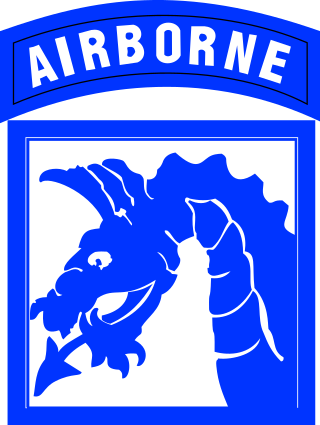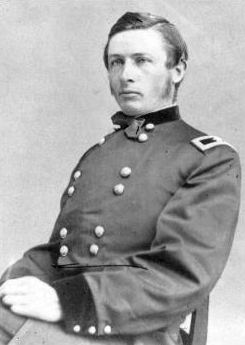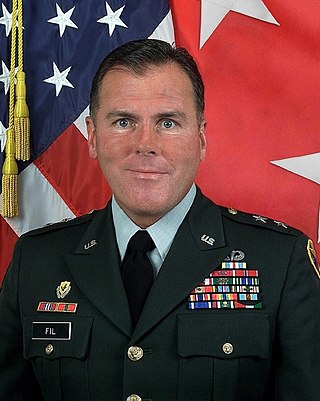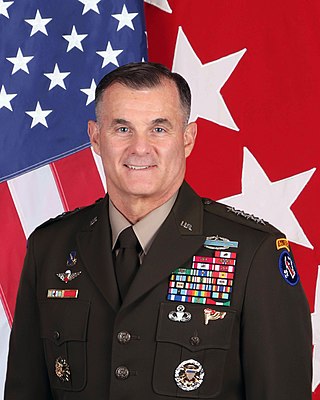
The XVIII Airborne Corps is a corps of the United States Army that has been in existence since 1942 and saw extensive service during World War II. The corps is designed for rapid deployment anywhere in the world and is referred to as "America's Contingency Corps." Its headquarters are at Fort Liberty, North Carolina.

The 1st Infantry Division (1ID) is a combined arms division of the United States Army, and is the oldest continuously serving division in the Regular Army. It has seen continuous service since its organization in 1917 during World War I. It was officially nicknamed "The Big Red One" after its shoulder patch and is also nicknamed "The Fighting First." The division has also received troop monikers of "The Big Dead One" and "The Bloody First" as puns on the respective officially sanctioned nicknames. It is currently based at Fort Riley, Kansas.

Fort Moore is a United States Army post near Columbus, Georgia, adjacent to the Alabama–Georgia border. Fort Moore supports more than 120,000 active-duty military, family members, reserve component soldiers, retirees and civilian employees on a daily basis. As a power projection platform, the post can deploy combat-ready forces by air, rail, and highway for their designated mission. Fort Moore is the home of the United States Army Maneuver Center of Excellence, the United States Army Armor School, United States Army Infantry School, the Western Hemisphere Institute for Security Cooperation, elements of the 75th Ranger Regiment, the 1st Security Force Assistance Brigade, and other tenant units.

Kenneth O. Preston is a retired United States Army soldier who served as the Sergeant Major of the Army. He was sworn in as the 13th Sergeant Major of the Army on January 15, 2004. Preston served 7 years and 2 months as Sergeant Major of the Army making him the longest serving Sergeant Major of the Army to date.

Ranald Slidell Mackenzie, also called Bad Hand, was a career United States Army officer and general in the Union Army during the American Civil War. He was described by General Ulysses S. Grant as its most promising young officer. He also served with great distinction in the following Indian Wars.

Albert Bryant Jr. is a retired United States Army brigadier general, best known for service as the Chief of Western Hemisphere Operations during and in the aftermath of the September 11 attacks and for his tenure as the Assistant Division Commander of the 4th Infantry Division at the time of the division's detection and capture of deposed Iraqi president Saddam Hussein. Bryant also served as the Deputy Commander of Fort Knox, Kentucky, and the United States Army's Armor School. As Chief of Staff of NATO's Kosovo Force (KFOR), Bryant was the highest ranking American general on the KFOR leadership team in the lead up to Kosovo independence.

Carter Frederick Ham is a retired United States Army general who served as the second commander of United States Africa Command. As commander of Africa Command, he led Operation Odyssey Dawn, the initial United States role in the 2011 military intervention in Libya.

Gale S. Pollock is a retired United States Army major general who served as the Deputy Surgeon General of the United States Army from October 2006 to March 2007, and also as chief of the Army Nurse Corps. She became acting Surgeon General of the United States Army for nine months following the 20 March 2007 retirement of her predecessor, Kevin C. Kiley, due to fallout from the Walter Reed Army Medical Center neglect scandal. She was the first woman and the first non-physician to hold the position.

Major General Joseph Frederick Fil Jr. was commissioned a Second Lieutenant in the United States Army in June 1976. He is a Distinguished Military Graduate of San José State University. He has served in Army units in the United States, Germany, Belgium and Iraq.

Peter William Chiarelli is a retired United States Army general who served as the 32nd Vice Chief of Staff of the United States Army from August 4, 2008 to January 31, 2012. He also served as commander, Multi-National Corps – Iraq under General George W. Casey, Jr. He was the Senior Military Assistant to the Secretary of Defense from March 2007 to August 2008. He retired from the United States Army on January 31, 2012 after nearly 40 years of service, and was succeeded as Vice Chief of Staff by General Lloyd J. Austin III.
Military psychiatry covers special aspects of psychiatry and mental disorders within the military context. The aim of military psychiatry is to keep as many serving personnel as possible fit for duty and to treat those disabled by psychiatric conditions. Military psychiatry encompasses counseling individuals and families on a variety of life issues, often from the standpoint of life strategy counseling, as well as counseling for mental health issues, substance abuse prevention and substance abuse treatment; and where called for, medical treatment for biologically based mental illness, among other elements.

Daniel William Christman is a retired United States Army lieutenant general, former Superintendent of the United States Military Academy (1996–2001), and the current Senior Vice President for International Affairs, U.S. Chamber of Commerce. A 1965 graduate of West Point, he went on to earn multiple post-graduate degrees and hold numerous commands during his army career. Christman served in highly visible and strategically important positions and four times was awarded the Defense Distinguished Service Medal, the nation's highest peacetime service award.

Rebecca Stevens "Becky" Halstead is a former United States Army officer and the first female graduate of West Point to become a general officer. She was the 34th Chief of Ordnance and Commandant of the United States Army Ordnance Center and Schools at Aberdeen Proving Ground, Maryland.

Mark Phillip Hertling is a former United States Army officer. From March 2011 to November 2012, he served as the Commanding General of United States Army Europe and the Seventh Army. Hertling served in Armor, Cavalry, planning, operations and training positions, and commanded every organization from Platoon to Field Army. He commanded the 1st Armored Division and Task Force Iron/Multinational Division-North in Iraq during the troop surge of 2007 to 2008.
United States v. Hasan K. Akbar was the court-martial of a United States Army soldier for a premeditated attack in the early morning hours of March 23, 2003, at Camp Pennsylvania, Kuwait, during the start of the United States invasion of Iraq.

Daniel Robert Hokanson is a four-star general in the United States Army who currently serves as the 29th chief of the National Guard Bureau. He previously served as the 21st director of the Army National Guard. His previous military assignments include serving as vice chief of the National Guard Bureau, deputy commander of United States Northern Command, adjutant general of the Oregon National Guard, and commander of the 41st Infantry Brigade Combat Team. He is a veteran of Operation Iraqi Freedom, Operation Enduring Freedom, and Operation Just Cause. Hokanson assumed his current assignment on 3 August 2020.

Joseph Matthew Martin is a retired general in the United States Army who served as the 37th Vice Chief of Staff of the Army from 2019 to 2022. He previously served as the director of the Army Staff in Washington, D.C.

Dennis Scott McKean is a retired United States Army lieutenant general who last served as deputy commanding general for Army Futures Command and the Director, Futures and Concepts Center. He previously served as the chief of staff for United States Central Command.

Charles A. Flynn is a United States Army general who serves as commanding general of United States Army Pacific since 4 June 2021. He previously served as Deputy Chief of Staff for Operations, Plans and Training (G3/5/7) of the Army Staff from June 2019 to May 2021. He is the younger brother of Lieutenant General Michael T. Flynn, Donald Trump's first National Security Advisor.

Lieutenant General Arthur J. Gregg, (retired) is the first African American in the U.S. Army to reach the rank of Lieutenant General on July 1, 1977. Previously, he was the first African American to reach Brigadier General in the U.S. Army Quartermaster Corps on October 1, 1972. He served in the U.S. Army for over 30 years with his final assignment as the Army's Deputy Chief of Staff (Logistics) and retired on July 24, 1981.


















